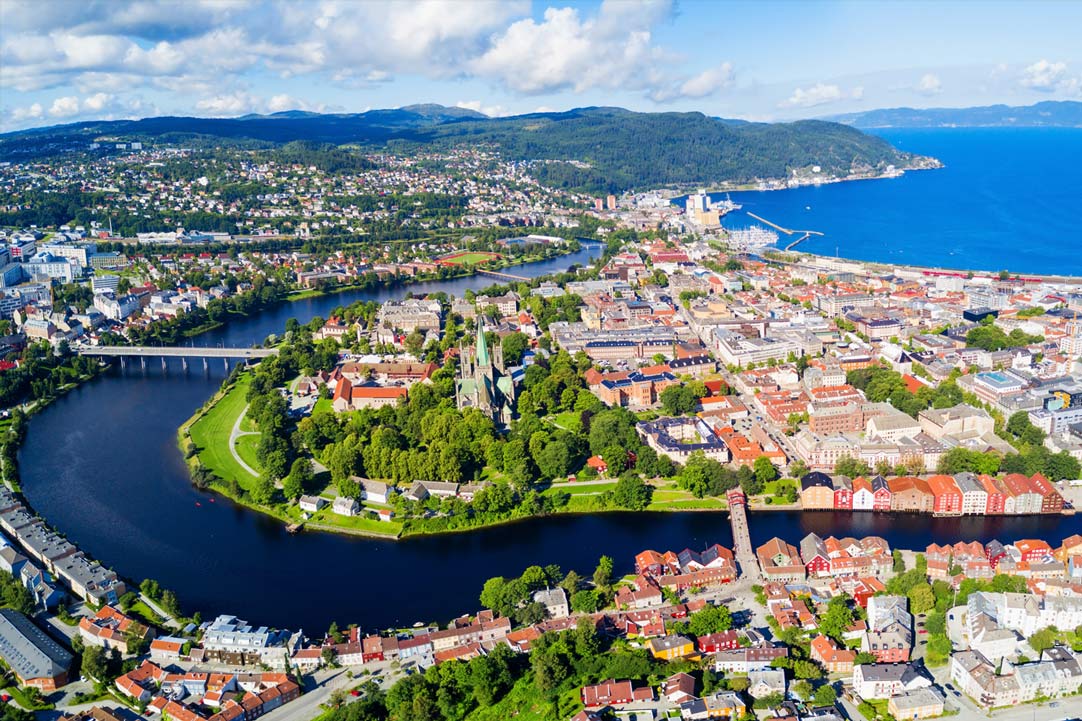The original home of most of the founders of Sons of Norway, Trøndelag county spreads across the central section of the country. Its 16,000 square miles are dominated by mountains, with slips of green valley tucked along its coasts, fjords and rivers. Its most notable natural feature is the Trondheim Fjord, which slices about 80 miles inland; first southward to Trondheim, then jagging northeast up to the town of Steinkjer.
 The largest city in the fylke is Trondheim, which served as the capital of Norway during the Viking age until 1217. Sainted King Olaf II was famously slain in the Battle of Stiklestad, about 60 miles north of Trondheim, in 1033. His remains rest beneath the floors of Nidaros Cathedral. The historic St. Olav’s Way pilgrimage route from Oslo over the Dovre Mountains to the cathedral is still undertaken by intrepid travelers today. Sons of Norway lodge Nidaros 8-006 in Trondheim was founded in 1984.
The largest city in the fylke is Trondheim, which served as the capital of Norway during the Viking age until 1217. Sainted King Olaf II was famously slain in the Battle of Stiklestad, about 60 miles north of Trondheim, in 1033. His remains rest beneath the floors of Nidaros Cathedral. The historic St. Olav’s Way pilgrimage route from Oslo over the Dovre Mountains to the cathedral is still undertaken by intrepid travelers today. Sons of Norway lodge Nidaros 8-006 in Trondheim was founded in 1984.
Trondheim is renowned as the home of Norges teknisk-naturvitenskapelige universitet (NTNU), the Norwegian University of Science and Technology. NTNU was formed in 1996 through the merger of 6 different well-established educational institutions. Over 42,000 students, half studying technology and natural science, congregate on campuses flung far and wide throughout the city.
About 95 miles southeast of Trondheim, you can travel back in time to the copper mining village of Røros – a UNESCO World Heritage Site. Look to the December 2021 issue of Viking magazine to discover more about this living museum.
One folk tradition specially preserved in Røros is the rørospols: the last vestige of a couple’s folk dance which was popular across northern Scandinavia 500 years ago. It is believed to have originated as a wedding dance. It starts off slow and dignified, and then transforms into a fast, wild circle dance as the couple spins around the dance floor like a top.
A town of a few thousand in the southern half of the county, Selbu is not only the birthplace of most of our founders, but of one of Norway’s national symbols- the selbuvott or Selbu mitten. Marit Guldsetbrua Emstad made quite a stir when she wore her intricately-patterned black and white mittens to church in 1857. Soon everyone in town was knitting them, making increasingly elaborate designs based on folk motifs. The eight-pointed Selbu rose is a cornerstone, though there are upwards of 300 patterns. Selbu mittens were in such demand across Norway, they created a cottage industry that allowed local women to make income from home. By 1900, the mittens took off internationally.
Trøndelag is also part of the territory of the South Sami people. Snåsa, which is 109 miles northeast of Trondheim at the tip of lake Snåsavatnet, is a bilingual municipality which is dedicated to preserving the South Sami language, handicrafts and identity. At Saemien Sijte, the South Sami Museum and Cultural Center, visitors can learn about reindeer husbandry, enjoy traditional storytelling, and practice their lasso skills.
From its national parks to its cultural centers, Trøndelag county officers something for everyone. It is a great place to explore the very heart of the Norwegian experience.
